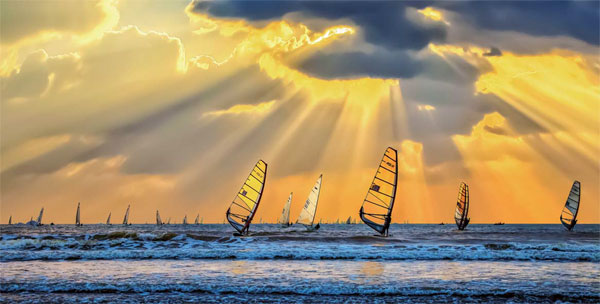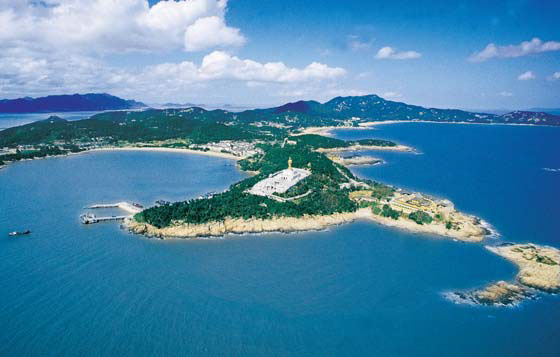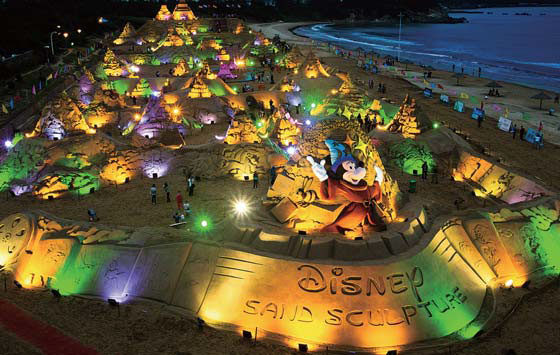Tourists head to archipelago city
|
Zhujiajian in Zhoushan is a lively place with beaches full of activities. Water sports including sea fishing and windsurfing, are very popular. Photos Provided to China Daily |
Zhoushan offers visitors scenery, seafood, sand sculpture and more
In the easternmost part of Zhejiang province there is an archipelago district formed by 1,390 islands. Zhoushan city, the only archipelago city in China, boasts breathtaking scenery that attracts millions of tourists every year.
The weather in Zhoushan is humid year round with clear air that ranked second-best in the Chinese mainland for the past two years. When residents in North China suffer from smog and haze, they often go to Zhoushan to escape the pollution.
Surrounded by the East China Sea, Zhoushan represents a variety of aspects of China's sea culture. It is home to Putuo Mountain, the largest area of the country where Kwan-yin, also known as Guanyin Bodhisattva, is worshipped. Zhujiajian is known as the cradle of sand-sculpting in China and the Shenjiamen fishery port offers people the chance to taste hundreds of varieties of seafood. Also, the area's 1,390 islands showcase a huge range of scenery.
Of all the attractions, Putuo Mountain is the most well known. It is one of the four sacred Buddhist mountains in China and has welcomed visitors for thousands of years. Historical records show that the earliest worshipers came to Putuo during the Qin Dynasty (221-206 BC). Today, Buddhists from regions including Chinese mainland, Taiwan, Hong Kong, as well as Malaysia and the Philippines come to the mountain to seek blessings from Kwan-yin.
There are three temples and more than 20 tourism sites in the mountain area, all related to Buddhist culture. The mountain is on a 12.5-square-kilometer island with views of the ocean, temples, cliffs, caves and sandy shores. The island is regarded by some as one of the most peaceful places in China.
For tourists who are not familiar with Buddhist culture, a 70-minute show, Impression Putuo, is an enlightening experience. Co-directed by famous Chinese film directors Zhang Yimou, Wang Chaoge and Fan Yue, the show illustrates how people, frustrated by all kinds of anxieties, find inner peace.
During the performance, the auditorium revolves, giving the audience the illusion that the actors and mountain are moving. The colorful lighting, three-dimensional projection and moving music take the audience inside the experience of seeking a peaceful mind.
While Buddhism helps people to escape from the worries of their daily lives and enjoy peace and tranquility, Zhujiajian is also a lively place with beaches full of activities.
One beach, Nansha, is home to China's sand-sculpture art. Since Zhoushan introduced sand sculpture to China in 1999, the art form has become a symbol of the city. It is also a driving force for the city's tourism and cultural industries.
Every September, sand sculptors from around the world gather in Nansha and get to work in the sand. Their sculptures are maintained on the beach until a new group of artists start afresh the following year.
Apart from the sand sculptures, water sports, including sea fishing and windsurfing, are also popular in Zhoushan. At Zhoushan Alpha Yacht Club, 108 berths and sailing courses are offered.
Zhoushan also offers visitors the chance to sample delicious seafood. Shenjiamen fishery port is China's largest natural fishery port and it was listed among the world's top three, together with Bergen port in Norway and Callao port in Peru.
When night falls, the 5-kilometer port lined with fishing boats waiting to sail out lights.
Restaurants by the port offer fresh seafood to customers, who can dine by the waterfront and enjoy the sea breeze.
yanyiqi@chinadaily.com.cn
|
Putuo Mountain is the largest area in the country where people worship to Kwan-yin, also known as Guanyin Bodhisattva. |
|
A night scene shows the sand sculpture festival at Nansha beach. Sand sculpture has become a symbol of the city and is also a driving force for the city's tourism and cultural industries. |
(China Daily 10/12/2015 page6)





















